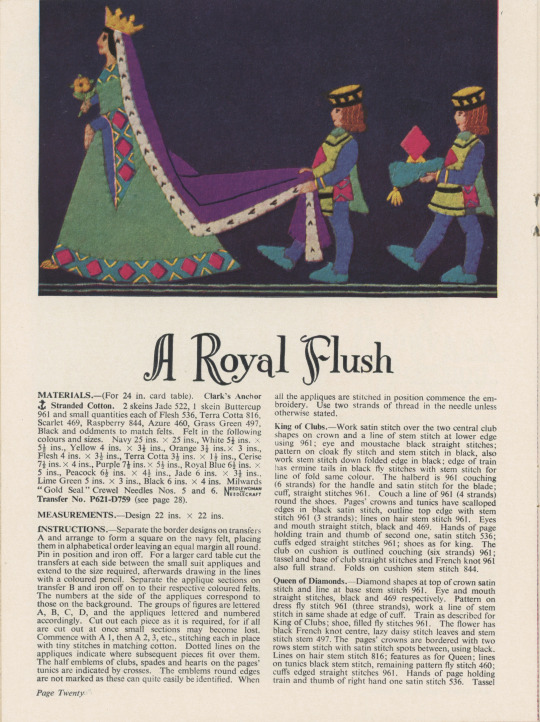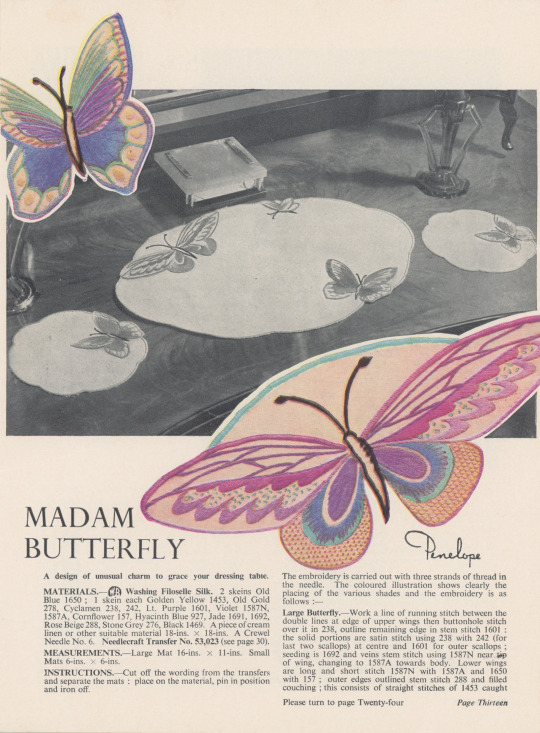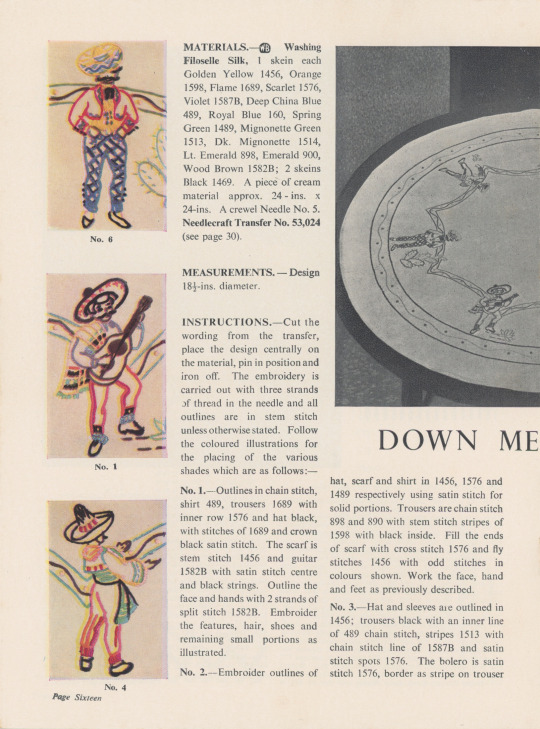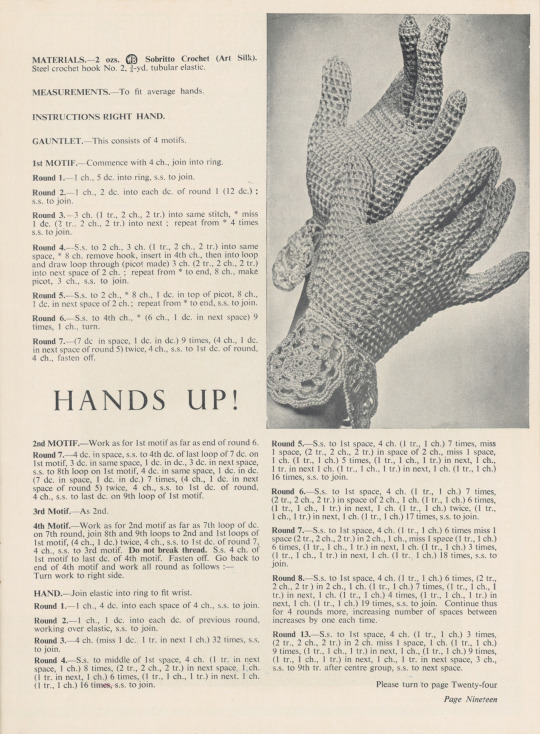#needlewoman
Text

Needlewoman - Lake Inle, 2017
#travel#myanmar#original photographers#photographers on tumblr#street photography#b&w photography#monochrome#cute girl#needlewoman#needlework#working woman#black & white
25 notes
·
View notes
Text










Needlewoman and Needlecraft No. 44 (Oct 1950) (UK)
Pages 11 – 20
#vintage knitting#knitting magazine#knitting#vintage crafts#1950s#1950s fashion#cross stitch#embroidery#vintage embroidery#vintage needlework#needlepoint#crochet#vintage crochet#needlewoman and needlecraft#needlewoman and needlecraft 44
34 notes
·
View notes
Text

The Needlewoman, Diego Velasquez c. 1640/1650
#diego velazquez#art#oil painting#painting#history#art history#1640s#17th century#europe#european art#brown
178 notes
·
View notes
Text
Mr. Holmes Maid (3)

Summary: You’re his maid.
Pairing: Sherlock Holmes x Maid!Reader
Warnings: angst, power imbalance, dub-con (just in case cuddling/sharing a bed), master-servant relationship, the reader was an orphan, inappropriate behavior
Mr. Holmes Maid (2)
Mr. Holmes’ maid masterlist

The red dress is even more opulent and expensive than the others. You feel like an imposter standing in front of your master in a dress that shouldn’t cover your body.
“Wonderful,” the needlewoman coos. She clasps her hands together and smiles at you. “She looks so beautiful, doesn’t she, Mr. Holmes.” She wants to hear a compliment for her handiwork, not how you look in the dress.
“Mr. Holmes,” you dare not complain, but you don’t feel comfortable wearing a dress made for a lady, not a peasant. “Isn’t that too much? I can’t clean in this kind of dress.”
“It’s for special occasions,” he hastily says while pushing a few looks out of his face. “If we receive guests and such.” The lie easily rolls off his tongue. He straightens his back and looks at the owner of the shop straight in the eyes. “Right, Mr. Stevenson.”
“Oh, of course, Mr. Holmes,” the man almost cowers in front of your master. If he’d lick Sherlock’s polished shoes, you wouldn’t be surprised. “She will look lovely while serving your guests.”
No one at the shop believes Sherlock wants you to wear this dress for his guests. He wants you to wear them only for you.
“Wonderful,” your master finally says. “We will take them all. Maid,” he sternly looks at you. “You can redress after I paid for everything. I’ll be waiting outside for you. Don’t waste time, we need shoes for you too.”
“Shoes,” you murmur while watching Sherlock with curiosity. He’s so different now. Moments ago, he was all soft on you and placed his hand on the small of your back. And now, he orders you around.
“Yes, shoes, maid,” he grumbles. “Let’s proceed then.”
You wrinkle your forehead. What else does he want to buy for you today?
Sherlock leaves you and the needlewoman alone to talk to the owner about payment, and another order.
“My dear,” the woman whispers so no one can hear her. “He’s charming, smart, and very handsome. But be careful. You’re only a maid. If anyone finds out about your affair,” she looks around the shop, “you will be the one to blame.”
“I—no,” you gasp at her bluntness. “I…we…no. We never... I wouldn’t dare…” You shake your head. “Mr. Holmes never did such a thing, madame.”
“I’m not a madame, my dear,” she chuckles lightly. “I was you not so long ago.” She dips her head to watch her husband and Sherlock talk. “My husband saved me from ending up on the street after my master promised me love and devotion.”
You don’t know what to say, so you remain silent.
“After he stole my innocence, he tossed me out on the street like a stray cat,” she whispers. “If you ever need help,” she grabs your hand, squeezing it, “come back here. We have a spare room.”
You nod and give her a quick smile. Your heart is racing, just like your mind.
Is that what Sherlock wants? Steal your innocence and kick you out. Is this his way to remind you of your place? Maybe he tries to fool you, believing you’re just a dull maid, unable to think for yourself.
“Thank you,” you utter and ask her to help you redress. You need to get the expensive dress off of your body, or you’ll faint imagining all the things Sherlock could do to you if you let him…

“Are you unwell,” Sherlock watches you fidget in your seat at the carriage. “What is it, Y/N?”
“The dresses and all that,” you dare not to meet his gaze, “I can’t wear them. It’s inappropriate. I got my clothes and…guests wouldn’t want to see me in such a dress. It’s too…pretty.”
“I bought them,” he sternly replies. “So, you will wear them.” Sherlock’s features soften when you choke out a sob. “Y/N, you helped me so often while I was lost in a case. You made sure that I ate properly and got dressed. You even brushed my locks. Consider the dresses and coat a gift to thank you for your assistance with my cases.”
“I did my duty, Master Holmes,” your voice trembles when he looks at you with soft blue eyes. “Helping you and taking care of you is my honor.”
He smiles at your words. “You’re so…” Sherlock swallows the sweet words he wanted to say. He cannot say them. This would confuse you even more. “Caring and selfless.” He says instead. “If I offer a gift to you, I expect you to take it.”
“Yes, master.”
Sherlock sighs deeply. His words came out wrong, and now you shy away, believing you did something wrong. He wants to take the words back, but that’s just not him.
“We will be home soon, maid,” he softly says. “We should rest soon. It was a rather long and exhausting day for you.”
“What about dinner? I can still prepare everything,” you try to make things up to Sherlock. He bought all these nice things for you, and you could only think of the things the needlewoman said to you.
Sherlock brushes his hand over yours, gently touching it for a moment. “We have leftovers from last night. You need to rest. Tomorrow, we need to talk about a few things.”
You nod and drop your gaze. “Will you send me away now? Did I anger you?”
“What?” He gasps at your words. “No…I…” Sherlock grabs your hand to hold it tightly. “I would never let you go. And you did not anger me, Y/N.” He murmurs. “It’s late and we should not think of anything but to rest.”
Your heart races feeling his large hand hold yours. He doesn’t let go and interlaces his fingers with yours. Sherlock breaks another rule, but there is no one but you and him in that carriage.
Who shall judge him for wanting to hold your hand?

You pace back and forth in your bedroom. Sherlock said goodnight and tried to read some papers while he sent you to bed.
Now the words of needlewoman echo in your mind. What if she’s right? Maybe he tries to charm his way into your bed. You heard stories from other maids. Their masters did the same.
Sherlock never made any promises. He just came to your bed and slept next to you, seeking your warmth and closeness.
It’s all so confusing and you don’t know if you can resist his advances. Your heart, and maybe your soul too belongs to Sherlock for the longest time.
The moment he took you to his maid, you were lost, and you don’t know if that’s a bad thing…

Tags in reblog.
#sherlock holmes#sherlock holmes x reader#sherlock holmes x you#Mr. Holmes Maid (3)#sherlock holmes x y/n#maid reader#sherlock x reader#sherlock x you#x reader
299 notes
·
View notes
Text


medieval women week (day four)
favourite non-royal woman: christina of markyate (1095-1155)
Christina of Markyate was born with the name Theodora in Huntingdon, England, within 1095–1098 and died in 1155. She was an anchoress, who came from a wealthy English family trying to accommodate with the Normans at that time. Later on she became the prioress of a community of nuns. Her mother told a story of “knowing” her daughter would be holy because a dove had flown into her sleeve and lived there for seven days while she was pregnant. Theodora visited St Alban’s Abbey in Hertfordshire with her parents as a teenager, and the visit apparently instilled in her a deep faith that prompted her to make a private vow of chastity. Christina found shelter with a sub deacon of St Alban’s Abbey, whose cell was at Markyate. She spent her time in prayer, sewing to support herself. She was a skilled needlewoman, who later embroidered three meters of superb workmanship for Pope Adrian IV. Christina’s hagiography is considered to be one of the most realistic that we know of. Some parts still follow the typical route of hagiographies, a vow of chastity, overcoming all obstacles including marriage, and even being an anchoress, although it is incomplete as parts of it were lost in a fire in the 18th century and it is unknown whether the biographer wrote the account before or after her death.
#medievalwomenweek#my stuff#christina of markyate#medieval women#medieval england#historicwomendaily#anchoresses#women of the middle ages#english history#medieval history
31 notes
·
View notes
Text

The Needlewoman painted by Diego Velazquez (1599 - 1660)
115 notes
·
View notes
Text
Though Fëanor after the days of his first youth took no more active part in linguistic lore and enquiry, he is credited by tradition with the foundation of a school of Lambengolmor or ‘Loremasters of Tongues’ to carry on this work.
-The War of the Jewels, Chapter: QUENDI AND ELDAR
In light of my previous reblog about the issue of the change of þ > s, I posit that it was likely his failure to prevent or reverse its spread among the wider populace that led to Fëanor's resignation from further participation in linguistic discourses.
As had been noted in the original post, Fëanor's position against the shift was the one widely held by all other actual loremasters and linguists, and it was only due to the politicisation of the issue, out of personal dislike and rejection of Fëanor as a political figure (not least out of a support for Nolfinwë in particular, later on), that it was rejected.
Into the strife and confusion of loyalties in that time this seemingly trivial matter, the change of þ to s, was caught up to its embitterment, and to lasting detriment to the Quenya tongue.
Had peace been maintained there can be no doubt that the advice of Fëanor, with which all the other lore-masters privately or openly agreed, would have prevailed. But an opinion in which he was certainly right was rejected because of the follies and evil deeds into which he was later led. He made it a personal matter: he and his sons adhered to þ, and they demanded that all those who were sincere in their support should do the same.
Therefore those who resented his arrogance, and still more those whose support later turned to hatred, rejected his shibboleth.
-The Peoples of Middle-Earth, Chapter 11: THE SHIBBOLETH OF FËANOR
Which would have rankled Fëanor something fierce, not only due to the emotional component of his mother and her memory, but also because he was one of the Noldor's chief linguists, and yet his expertise was rejected due to politics. "In favour" of personalities never associated with linguistic studies in any way and that he was already predisposed to dislike without mangling one of his "crafts".
The change was a general one, based primarily on phonetic ‘taste’ and theory, but it had not yet become universal. It was attacked by the loremasters, who pointed out that the damage this merging would do in confusing stems and their derivatives that had been distinct in sound and sense had not yet been sufficiently considered.
The chief of the linguistic loremasters at that time was Fëanor. He insisted that þ was the true pronunciation for all who cared for or fully understood their language.
(While the first experp seemingly suggests that the main "switch" occured only during the Darkening, other parts make clear that it had set in earlier:)
Indis was a Vanya, and it might be thought that she would in this point at least have pleased Fëanor, since the Vanyar adhered to þ. Nonetheless Indis adopted s. Not as Fëanor believed in belittlement of Míriel, but in loyalty to Finwë.
For after the rejection of his prayers by Míriel Finwë accepted the change (which had now become almost universal among his people), although in deference to Míriel he had adhered to þ while she lived. Therefore Indis said: ‘I have joined the people of the Ñoldor, and I will speak as they do.’
I also have to scratch my head over how one expected Míriel's son to take this as anything other than a disrespect to her and her (forced) sacrifice, since it says black on white that, while Míriel was still alive, Finwë had respected her position on the issue, but now that she was dead for presumably until the end of the world, 100% due to Finwë's and Indis' marriage, well, he didn't need to bother respecting her wishes anymore, did he? Out of sight, out of mind.
She [Míriel] was therefore called Þerindë (Needlewoman) – a name which she had indeed already been given as a ‘mother-name’. She adhered to the pronunciation þ (it had still been usual in her childhood), and she desired that all her kin should adhere to it also, at the least in the pronunciation of her name.
I don't think respecting someone's wish for their name to be pronounced properly (so according to their preference) is too much to ask, really. Imagine having people, including your father and your step-mother, who got that position through agreement that your mothers eternal death was an acceptable sacrifice, deliberately mispronounce her name to your face.
Fëanor was a saint for not starting fist-fights over this and instead simply moving out as soon as possible, focusing on his own joys. But it's not like a lack of respect for Míriels rights and dignity was something new, afterall.
When it became clear at last that Míriel would never of her own will return to life in the body within any span of time that could give him hope, Finwë’s sorrow became embittered. He forsook his long vigils by her sleeping body and sought to take up his own life again [...].
[Wanders and meets Indis]
So it came to pass that Finwë and Indis desired to be wedded, and Finwë sought the counsel of the Valar. [...]
It was judged that Finwë’s bereavement was unjust, and by persisting in her refusal to return Míriel had forfeited all rights that she had in the case; for either she was now capable of accepting the healing of her body by the Valar, or else her fëa was mortally sick and beyond their power, and she was indeed ‘dead’, no longer capable of becoming again a living member of the kindred of the Eldar.
‘So she must remain until the end of the world. For from the moment that Finwë and Indis are joined in marriage all future change and choice will be taken from her and she will never again be permitted to take bodily shape. Her present body will swiftly wither and pass away, and the Valar will not restore it. For none of the Eldar may have two wives both alive in the world.’
I can't even read this without getting incensed, the sheer lack of not only compassion but even just theoretic understanding for Fëanor's position and perspective of the matter is genuinely baffling to me, even from a purely "reading-comprehension" standpoint.
Míriel didn't adamantly refuse to ever return and Finwë made the best of it, the Valar repeatedly hounded her to return right now because what even was wrong with her, Finwë was lonely, and if she couldn't be healed RIGHT NOW she was clearly beyond healing FOREVER. Because Finwë had no hope she'd return in a manner timely enough to make him happy, because it was unfair for Finwë to remain without a spouse, so Míriel's rights to take the time she needed to heal before returning (as any elf in the Halls of Mandos is supposed to have, as are arguably their purpose) were suspended, because Finwë wanted to have his marriage and he wanted it now.
The Valar and all the Eldar were grieved by the sorrow of Finwë, but not dismayed: all things could be healed in Aman, and when they were rested her fëa and its body could be reunited and return to the joy of life in the Blessed Realm.
But Míriel was reluctant, and to all the pleas of her husband and her kin that were reported to her, and to the solemn counsels of the Valar, she would say no more than ‘not yet’.
Each time that she was approached she became more fixed in her determination, until at last she would listen no more, saying only: ‘I desire peace. Leave me in peace here! I will not return. That is my will.’
Instead of being left to recover from her weariness in peace, she got told over and over how much grief she had brought to everyone with her need for rest (apparently seriously expecting that to incentivise her to want to life again?). That's messed up! Her final plea, "I desire peace. Leave me in peace here!" just reeks of desperation, and also makes it clear (in conjunction with her previous "Not yet"s) that it's not to be taken as a definite statement of a desire to never return to life, but a desperate plea to finally be allowed to rest, the need for which caused her death in the first place.
But you want know the kicker of all this, that never fails to get me with its double standard?
During the time of his sorrow Finwë had little comfort from Fëanor. For a while he also had kept vigil by his mother’s body, but soon he became wholly absorbed again in his own works and devices.
Hey. Hey, remember that previous paragraph about how Finwe "forsook his long vigils by her sleeping body and sought to take up his own life again [...]"? Now Fëanor is suddenly depicted as callous for doing the very same thing that was depicted as admirably weathering his grief in Finwë's case, except he didn't even need to throw Míriel under the bus for it.
#silm#fëanor#finwë#Míriel#Quenya#todays rant about how Fëanor was right about everything and also the only one to show Míriel even basic decency and respect after her death
24 notes
·
View notes
Text
Favourite Female Tolkien Character Poll - Round 1, Match 1
Character information behind the cut! Add your own advocacy for your fave in reblogs!
Míriel Therindë
The greatest fabric artist and innovator among the Noldor, and the mother of Fëanor. Her death from overwhelming weariness shortly after Fëanor’s birth leaves her husband Finwë distraught. When she chooses to never return from the Halls, Finwë remarries - much to Fëanor’s discontent, as it means Míriel’s decision not to return will be irrevocable. After Finwë’s death and her reunion with him in the Halls of Mandos, she wishes to return to life, and Finwë chooses to remain dead to allow her to do so. She is grieved by what has passed since her death, and rather than return among the Noldor, she enters the house of Vairë the Weaver, and weaves tapestries of all the history of the Noldor.
She was a Noldorin Elda of slender and graceful form, and of gentle disposition, though as was later discovered in matters far more grave, she could show an ultimate obstinacy that counsel or command would only make more obdurate. She had a beautiful voice and a delicate and clear enunciation, though she spoke swiftly and took pride in this skill. Her chief talent, however, was a marvellous dexterity of hand. This she employed in embroidery, which though achieved in what even the Eldar thought a speed of haste was finer and more intricate than any that had before been seen. She was therefore called ‘Therindë’ (Needlewoman).
[After her return from the Halls of Mandos.] Míriel was accepted by Vairë and became her chief handmaid; and all tidings of the Noldor down the years from their beginning were brought to her, and she wove them in webs historical, so fair and skilled that they seemed to live, imperishable, shining with a light of many hues fairer than are known in Middle-earth.
Nerdanel
A great sculptor, and the wife of Fëanor and mother of seven sons. She is known as Nerdanel the Wise, and is the only person whose counsel Fëanor ever took, but later in his life during the Unrest of the Noldor his deeds grieve her and they become estranged; she does not go with him when he is exiled from Tirion, nor when he leaves Valinor, and instead lives with Indis, whom she is friends with. During the Flight of the Noldor she pleads with him to leave at least some of their sons in Valinor, but he rebuffs her.
While still in early youth Fëanor wedded Nerdanel, a maiden of the Noldor; at which many wondered, for she was not among the fairest of her people. But she was strong, and free of mind, and filled with the desire of knowledge. In her youth she loved to wander far from the dwellings of the Noldor, either beside the long shores of the Sea or in the hills; and this she and Fëanor had met and were companions in many journeys.
Her father, Mahtan, was a great smith, and among those of the Noldor most dear to the heart of Aulë. Of Mahtan Nerdanel learned much of crafts that women of the Noldor seldom used: the making of things of metal and stone. She made images, some of the Valar in their forms visible, and others of men and women of the Eldar, and these were so like that their friends, if they knew not her art, would speak to them; but many things she wrought also of her own thought in shapes strong and strange but beautiful.
#favourite female tolkien character poll#miriel#nerdanel#the silmarillion#tolkien#history of middle earth#i may have gone overboard on the info!#two artistic geniuses!#I CAN ADD CUTS IN THE APP NOW THANK YOU TUMBLR STAFF!! 👏
57 notes
·
View notes
Text
@dunerover sent
"Needlewoman, huh?" Zandi perched himself across from Babette like he'd been invited, crouched like a monkey on a stump. His eyes glowed bright and curious, his smile warm and social. "Gotta be hard, roughin' it out here after Elturel. You still working, or just patchin' pants and stuff?"

𝕃𝔼𝕋𝕋𝔼ℝ𝕊 . unprompted interactions
────────────────────────
𝐍𝐞𝐞𝐝𝐥𝐞𝘄𝐨𝐦𝐚𝐧. Now that was a new one. Brows perk up in what could be described as surprise mixed with a healthy amount of irritation. Needlewoman. Babette decided this new nickname she earned herself was a token she could wear. Needles were her thing, after all. Everyone knew Needlewoman was good with needles.

❝ . . . And good afternoon to you too. ❞ Head tilts in a slight bow, still wearing this queried, soft frown on her pale face. In the slightest bit, it was amusing. Somehow. Eyes so eager to learn more, to ask & not afraid to do so, even if it meant to disturb her privacy.
❝ My work is always with me, one could say. Patching & fixing included. Even if I miss my sewing machine. But oh well, why do you ask ? Anything that could benefit from my humble hands' expertise. ? ❞
#dunerover#bahbsdhajvs what a cutie help#I wanna hug him hello darling baby#✂ ˚ The Hexed Seamstress ˚⠀⠀/ ic .
10 notes
·
View notes
Text
Meet Siqueira!
She's a needlewoman and works at clothing store she's a shopkeeper
I should you remember her🩵🪡🧵



Art belongs by @cloudysunflowr
Siqueira belongs by me
6 notes
·
View notes
Text

Title: The Needlewoman
Artist: Diego Velazquez
Date: 1635
Style: Baroque
Genre: Portrait
58 notes
·
View notes
Text
About Marie d'Anjou
After losing four children between 1436 and 1439, Marie began to dress all in black. She was devoted to her household, her religious duties and her children. She was admired for her piety, leading a devotional life. Marie appears to have had no chancellor in her household as her seal was kept by one of her ladies-in-waiting, perhaps in an effort to keep her household out of internecine politics at court. She normally resided at Tours or Amboise and did not usually travel with the court.
Marie kept a large menagerie of pets including starlings, parrots, a wild goat, stags and does, in addition to her greyhounds. She also received a porpoise as a gift. Perhaps this is where her son Louis learned to love such exotic pets. Marie was an expert needlewoman. Her account books for the years 1454 and 1455 attest she embroidered every day with gold thread from Cyprus, Genoa and Venice with a cushion stuffed with bulrush and patterns on canvas from Cambrai.
Marie had a musical chapel with fifteen members. Two of these chaplains were composers of polyphonic music. Marie was the first queen to officially have an astrologer in her household according to the account books of 1450. His name was Arnoul de La Palu and he was regularly paid by the queen until Arnoul left to go into the king's service. He was quickly replaced by Jehan de Lormont.
Marie remained very close to her family and frequently kept in touch with her brother René, Duke of Lorraine. René visited her and she borrowed his boats to sail up the Vienne and Loire Rivers for visits. A list of New Year's gifts for 1455 for the most part included gifts to her brothers and sister-in-law Joan of Laval. Marie and the king made a pilgrimage together to Le Puy in 1424. In 1447, Marie made a pilgrimage on her own to Mont St. Michel.
Susan Abernethy - Marie of Anjou, Queen of France
#xv#susan abernethy#marie of anjou queen of france#marie d'anjou#queens of france#louis xi#le roi rené#jeanne de laval
26 notes
·
View notes
Text











Needlewoman and Needlecraft No. 50 (April 1952) (UK)
Pages 12 – 22
#vintage knitting#knitting magazine#vintage crafts#knitting#vintage needlework#vintage crochet#needlework#crochet#cross stitch#vintage embroidery#embroidery#needlewoman and needlecraft 50#needlewoman and needlecraft#smocking#1950s#1950s fashion
23 notes
·
View notes
Note
This is my wh oc her name is Siqueira neddling she's a needlewoman and shopkeeper she's making some dress from your ocs!<3


*Gasps* ☆O☆
O ME GOSH YAAAAAAAASSSS!!! ( ˶ˆᗜˆ˵ )
Eeeeeeeeeeeeeeee! I'm so excited to see the pretty dresses!!
(Siqueria super cute btw! :3)
2 notes
·
View notes
Note
Advice on finishing seams without a serger?
I don’t really want to own a serger and I feel like they’re fairly recent machines anyway. There must be a better way to finish seams?
For my skirt I just turned the fabric twice and hemmed so it would be a nice finished edge. The issue is that then when I attached two seams, the poor needles had to go through 6 layers of fabric and sometimes I was at a corner and they had to go through so much it didn’t fit under the foot. There must be something I’m missing because this wasn’t even a thick fabric.
HALP PLS!!! 😭😭
Hello! I'm so sorry for the late response; I've had a few disruptions to my regular schedule in the last few weeks, and I wanted to give this a good, long, thorough answer. You absolutely don't need a serger; I'm pretty sure my grandmother has never owned one, and she's still wearing things she made back in the early 90s. I'm not as good a needlewoman as she is, but most of my stuff has held up at least as well as its storebought equivalent.
(Probably) the easiest and simplest option is just to zigzag over the edges of your fabric with a sewing machine. A serger essentially rolls sewing the seam, trimming seam allowances, and zigzagging/overcasting into one step. Depending on what you're making, you might want to trim seam allowances after sewing the seam, and then zigzag over the raw edges, or, if you've got a lot of short seams that won't fit nicely under the machine after you've sewn them, you should be able to zigzag over the raw edge of the fabric before you sew the seam. (The issue with the second option is that you'll have the full seam allowance left in there, but if you're doing that sort of precision piecing I expect the seam allowance will be narrow enough that it doesn't matter.)
This doesn't necessarily have to be a zigzag stitch proper; my mother's machine does a finishing stitch that looks a bit like a blanket stitch, and I've seen other variations. But practically every machine made after 1970 or so has a zigzag, so you'll probably have the equipment to do it. The key part is that you want to catch the edge of the fabric inside the stitch, so that the stitching thread is binding the last few threads of the fabric together.
The hand-sewing equivalent to this is whipping (whipstitching) the edge of your fabric with needle and thread. I generally don't put my handmade clothes through the dryer, but all of the ones I've finished with this method have been fine in the washing machine. Most of them have survived at least one trip through the dryer unscathed. I suppose you could also do a blanket stitch, but that seems like an unnecessary amount of work.
Other methods:
Seam binding: I haven't personally tried this one. It's usually used for heavier fabrics that won't be lined (a single-layer blazer or skirt, etc). I'm sure it has other applications, but I haven't seen it often.
Pinking: This is the old-school way to finish seams. I haven't really tried it myself.
French seams: These are annoying to do on a curve and can add a good amount of bulk, but they're a very clean finish. Usually used on lingerie and other lightweight fabrics (doing this in coating weight sounds like a nightmare but also a really good high fashion concept).
Flat-felled seams: This is the way the inside of your jeans is finished. Historically it was often used for shirts, shifts, and other high-wear areas where you wanted to avoid chafing. It's somewhat similar to the French seam.
All right, now for Sewing Confessions:
I'm pretty lazy when it comes to finishing my seams. I started sewing with historical stuff that wouldn't get washed super often and vintage dresses, all in quilting calico. (This is generally a bad idea but for some very specific eras of fashion it can work.) My most-washed historical piece was probably my chemise, which was sewn from old sheets. I didn't bother to do much finishing on any of these, partly because I didn't know how, and partly because I didn't really want to flat-fell all the seams in my chemise if nobody was going to see it. (Now that I'm thinking about it, I may actually have flat-felled most of my first chemise. I made a second one fairly quickly.) The other fabric I worked in was cotton flannel for nightwear.
With all of these pieces, the fabric began to wear out/get shabby long before the seam allowances frayed enough to make anything structurally unsound. I have popped a few stitches here and there which could have been saved by a more robust seam, but in general I didn't have many problems.
Once I was sewing in nicer fabrics (silk and rayon, especially), I started to have issues with seam finishing. So far, simple hand-overcasting has stood up well for most of these. My usual sewing machine is straight-stitch only, so zig-zagging hasn't been an option for most of these. They've held up fine so far.
Maybe if I got some really nice fabrics, it would be a different story; I'm not telling you not to finish your seams! But bargain-bin cotton flannel, in my experience, wears out too quickly to make conscientious finishing worth it. Don't stress too much about it! I'd advise, from what little I've seen of your sewing posts, to stick to a good zigzag, or whatever finishing stitch on your machine looks interesting. If you want to be strictly historical, try pinking or flat-felling, depending on era and context. When you make some really nice sheer blouses, then maybe pull out the French seams. When you're doing a pair of wool trousers, try seam-binding tape. Go forth and sew boldly!
#sewing#asks#please chime in if you're a follower of mine who sews!#I feel like my devil-may-care attitude towards seam finishing may be TOO cavalier#but honestly I haven't had many issues
5 notes
·
View notes
